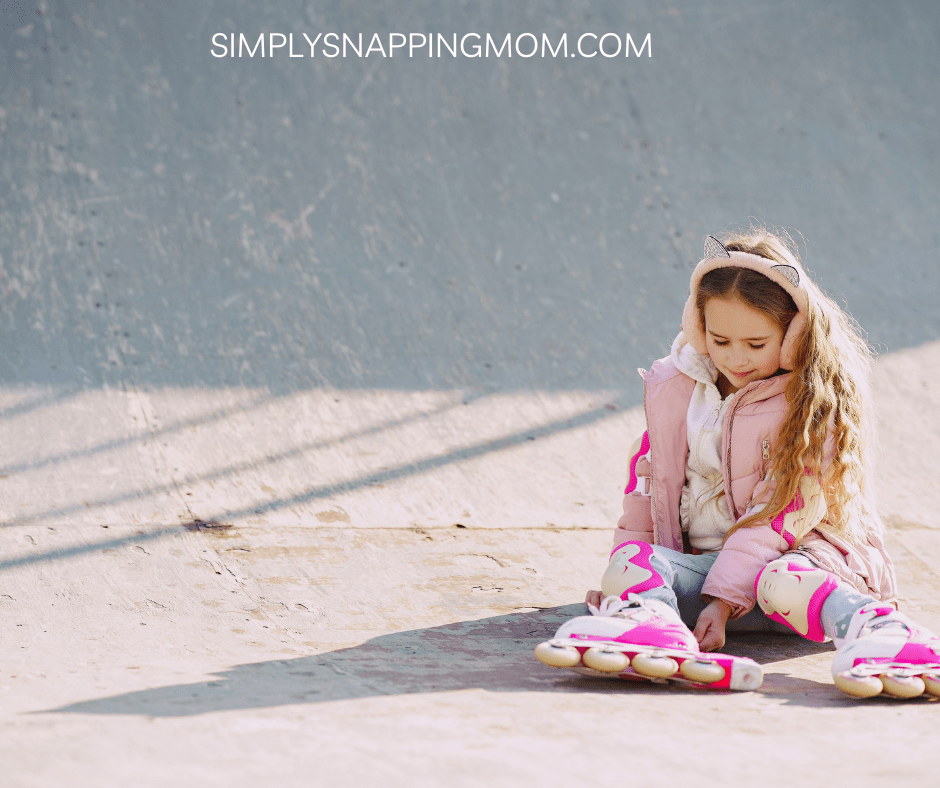Kids cry. But do you feel like your kid may need some extra support? Are you looking for parenting tips on how to stop a child from crying all the time over little things? Try these gentle solutions to help young children who can’t stop crying over spilled milk.
My middle child didn’t just cry over spilt milk. She cried over the tiny droplet of milk that splashed out, the color of the cup the milk was in, and the way I poured the milk. FYI, apparently there is a “wrong” way to pour milk in a cup.
When explaining her to my family and friends, I would say she had a low “cry threshold”.
In other words, it felt like her tears were on the brink of sliding down her face at all times, and even small things would open those unpredictable flood gates.
What didn’t feel like a big deal to me would induce temper tantrums in her.
It’s normal for kids to cry.
In fact, sadness is one of the four primary emotions that all humans share.
Additionally, clinical psychologist Donna Housman explains that children sometimes cry when they experience other big emotions – such as happiness, fear, and anger.
The good news is – there are powerful, yet simple, ways that parents and teachers can help the crying stop and create a safe place for young kids and older kids alike.
You may also like: How to Respond when your kid says “I hate you”

How much Crying is Normal for Kids?
Before trying to stop crying in kids, it’s important to understand why a kid is crying and if it is a normal amount.
The American Academy of Pediatrics (AAP) says 2 to 3 hours of crying a day from birth through the first 3 months of age is considered normal. This can be more frequent in a colicky baby.
As a child ages, we must focus more on why a kid is crying.
These are age appropriate reasons why a child may be wailing:
- Toddlers: 1 to 3 year olds are ruled by emotions. It is expected that your child’s emotions or current state, such as tired, hungry, frustrated, will result in tears.
- Preschool-aged: When a child reaches 4–5 years old, they may have a hard time with more advanced situations such as hurt feelings. Injury is also an expected and common reason for crying.
- School-age: For kids 5 years of age and older (until they develop adult brains) there are a variety of reasons that can trigger crying, including injury or loss of something special.
While crying at any age can be acceptable behavior (depending on the circumstance), parents must look for signs that something isn’t right.
Ask yourself these questions:
- Is your child having extreme outbursts on a daily basis?
- Did your child go from being a generally happy child to a sad child in a short time?
- Is your kid having a harder time with emotions than you would expect for their age?
Don’t take your child’s emotions and mental health lightly. Reach out to your pediatrician if you think your child may be struggling.
Learn how many Minutes of Quality Time Needed a Day to make your kid feel special

How to Help a Crying Kid
There are many different ways to help a crying child, but finding what works can be a parent’s biggest challenge.
This method is powerful, yet gentle for kids of all ages.
When combined, these 5 steps provide an effective way to help an upset child cope with a current problem and learn skills for the future.
1) Rule out Potentially Serious Conditions
When our kid’s are upset, the first thing we must do as parents is make sure there isn’t something more serious going on.
When children cry frequently, we often forget to rule out more complex behavioral conditions.
Some children who suffer from inconsolable crying may have an underlying condition such as autism, attention-deficit disorder, or sensory processing disorder. Learn about 6 conditions that can mimic strong willed behavior in kids here.
Also, about 20% of people have a highly sensitive personality, which could intense emotional reactions.
2) Rule out all the other little things
The power that hunger, fatigue, and straight-up discomfort has over children of all ages is real, too.
It may sound silly, but if your kid is crying, ask yourself these simple questions:
- Did we miss snack time? You’ve seen the commercials where a candy bar fixes someone’s mood. Being “hangry” (angry from hunger) is a real thing!
- Is lack of sleep a culprit? Could nap time be a quick fix?
- Could your kid be bored? They may benefit from a walk, game, or bike ride.
Related: How to help kids who are too shy to approach new situations
3) Check your own emotions at the door
Don’t let your own temper and own emotional state set a negative tone.
As a parent, you set the tone. If your child cries when you are stressed and upset, there is a good change that your child’s feelings and crying fits are linked to your mood.
Take a few deep breaths to hit the reset button when you feel yourself slipping away. Make sure your own facial expressions and body language don’t express anger or frustration with your child.
What if you already lost your temper? No problem, do these quick things after you yell to reconnect with your kid.

4) Validate feelings
Positive parenting experts preach the importance of validating a child’s emotions.
Next time your child cries, get down on their level and make eye contact. Tell them that you understand that they feel the way they feel.
Ask them open ended questions in a calm fashion to help them work through these thoughts. Try things like “tell me why you feel sad”.
A little physical contact goes a long way, so be sure to throw in a hug.
Teach Coping skills
Now, it’s time to get to the nitty gritty.
Use this difficult situation to teach your kid emotional regulation skills.
Give your kid these tools to guide them to calm down on their own and think through different situations that would usually make them cry.
Raise kids with a growth mindset, instead of a “poor me” mindset with these emotional intelligence tips.
You may also find helpful: How to deal with an argumentative child.
Final Thoughts on How to Stop a Child from Crying all the Time
These tips will help you give your kid the ability to clean up spilled milk without the meltdowns.
When you mix this method in with your own parental instincts and expert-level problem-solving skills (I know you got those), it is a great way to help a child deal with all those confusing, uncomfortable, and undeniably amazing emotions that make us human.
If you found this helpful, share it and follow us on Facebook for more honest parenting discussions.


5 Must-know Conditions that Mimic Strong-Willed Behavior in Kids - Simply Rooted Family
Wednesday 6th of April 2022
[…] Related: How to Help Kids who Can’t Stop Crying […]
How to Restore Peace and Deal with an Argumentative Child - Simply Rooted Family
Wednesday 6th of April 2022
[…] Related: How to Help a Child who Won’t Stop Crying all the Time […]
When Socks are the Enemy and Other Over Sensitive Child Symptoms - Simply Rooted Family
Wednesday 6th of April 2022
[…] emotional reactions- ex: cries easily and is prone to social […]
3 Trouble-free Ways Parents Can Handle Meltdowns and Tantrums in Kids - Simply Rooted Family
Wednesday 9th of March 2022
[…] You may also like: How to Help a Kid Who Cries all the Time […]
How to Talk to Kids About Scary World Events - Simply Rooted Family
Thursday 24th of February 2022
[…] You may also find helpful: How to Help a Child who Won’t Stop Crying […]